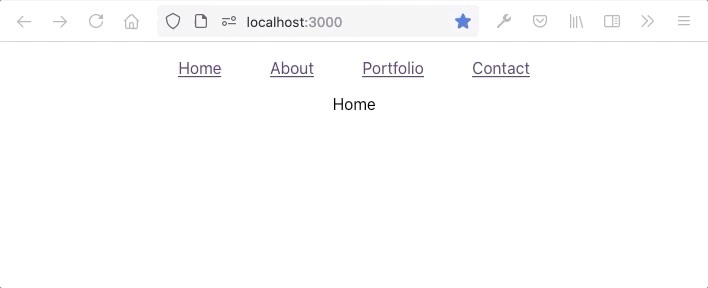An Interest In:
Web News this Week
- April 1, 2024
- March 31, 2024
- March 30, 2024
- March 29, 2024
- March 28, 2024
- March 27, 2024
- March 26, 2024
react-router setup
Introduction
Developers cannot build more than one-page web application in React because React is a single-page application (SPA). Therefore, a web application that is built in React will not reload the page. How we can make more than one page then? react-router is the answer to this question. react-router gives us the flexibility to render components dynamically based on the route in the URL. These are the steps how you can set up your react-router in react application.
Installation
As usual, we need to install the package by running this command in the terminal.
npm install react-router-dom// oryarn add react-router-domPrimary Components
According to react-router documentation, there are three main categories of components in react-router (routers, route matchers, and navigation).
- routers ->
<BrowserRouter>and<HashRouter> - route matchers ->
<Route>and<Switch> - navigation ->
<Link>,<NavLink>, and<redirect>
Routers
The difference between <BrowserRouter> and <HashRouter> is the URL link. <HashRouter> could store a hash in the link http://example.com/#/your/page, and usually, we use it to refer to several sections in the page.
We must put a router in the top hierarchy component. I usually place the <BrowserRouter> in the index.js and wrap the <App/> component.
// ./src/index.js// ...import { BrowserRouter as Router } from 'react-router-dom';ReactDOM.render( <React.StrictMode> <Router> <App /> </Router> </React.StrictMode>, document.getElementById('root'));Route Matchers
The idea of route matchers is to declare the conditional rendering components corresponding with the URL. I might say <Route> is similar to "if statement", and <Switch> is similar to switch statement. Take a look at the snippets below.
Using Route
// ./src/App.js// ...import { Route } from 'react-router-dom';function App() { return ( <div className="App"> <Nav /> {/* I will show this components in the next section */} <Route path="/about"> <About /> </Route> <Route path="/portfolio"> <Portfolio /> </Route> <Route path="/contact"> <Contact /> </Route> <Route path="/"> <Home /> </Route> </div> );}If we are not using <Switch>, it will render <About /> and <Home /> components at the same time when users go to the localhost:3000/about link. It renders two components at the same time because /about matches with "/about" and "/" paths.
We can solve more than one component at the same time by adding the exact attribute.
<Route exact path="/about"> <About /></Route><Route exact path="/portfolio"> <Portfolio /></Route><Route exact path="/contact"> <Contact /></Route><Route exact path="/"> <Home /></Route>or we can use the <Switch> component like this snippet below.
Using Switch
// ./src/App.js// ...import { Switch, Route } from 'react-router-dom';function App() { return ( <div className="App"> <Nav /> {/* I will show this components in the next section */} <Switch> <Route path="/about"> <About /> </Route> <Route path="/portfolio"> <Portfolio /> </Route> <Route path="/contact"> <Contact /> </Route> <Route path="/"> <Home /> </Route> </Switch> </div> );}a quick note about why I put
path="/"in the last of Route. If I putpath="/"in the beginning, other Route will not render at all. When users go tolocalhost:3000/about, it will match with '/' first, and others will be ignored.
Navigation
Navigation components allow the website to create a new link in the URL without reloading the page like using an anchor tag (<a>). Whenever we are using the anchor tag, the page will be reloaded, and we cannot do that in SPA.
// ./src/components/Navbar/Navbar.js// ...import { Link } from 'react-router-dom';const Nav = () => { return ( <nav className={styles.wrapper}> <Link to="/">Home</Link> <Link to="/about">About</Link> <Link to="/portfolio">Portfolio</Link> <Link to="/contact">Contact</Link> </nav> );};export default Nav;NavLink
The main difference between <Navlink> and <Link> is styling purposes. If we want to give a style when the link is active we can use <NavLink> like the snippet below
<NavLink to="/contact" activeClassName="active"> Contact</NavLink>It will be rendered to be HTML like this if the users visit /contact.
<a href="/contact" className="active">React</a>Redirect
If this component renders, it will force to redirect to corresponding with the to prop.
<Redirect to="/login" />Conclusion
These three primary categories of react-router components are the basis of how we can apply react-router to our project. If we understand these three kinds of categories, it will be easier to implement react-router. I will share another advanced topic about react-router in the next blog.
Original Link: https://dev.to/raaynaldo/react-router-setup-5gml
Dev To
 An online community for sharing and discovering great ideas, having debates, and making friends
An online community for sharing and discovering great ideas, having debates, and making friendsMore About this Source Visit Dev To


